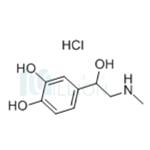Chemical Properties
solid
Uses
(±)-Epinephrine hydrochloride has been used:
- in the induction of renalase expression in Human renal proximal tubular epithelial cells
- in the infusion studies to test its effect on heart rate and eye temperature measurements in bull
- as a medium supplement for the stimulation of endothelial progenitor cells
Uses
An adrenergic receptor agonist.
General Description
Epinephrine (adrenalin) is synthesized from norepinephrine (noradrenalin) by the action of the enzyme phenylethanolamine
N-methyltransferase. Epinephrine comprises 5%-10% of the total catecholamines in the central nervous system. It is a mixed α/β-adrenergic receptor agonist and stimulates these receptors. Their site of synthesis is adrenal medulla and it travels through the vascular systems. Its breakdown occurs in the central nervous system (CNS), liver and kidney.
Biochem/physiol Actions
Epinephrine improves systemic pressure during cardiopulmonary resuscitation and is used post cardiac arrest. The levels of epinephrine increases during trauma, sepsis and hypoglycemia resulting in increased cardiac rate and contractility. It is used in the treatment of acute anaphylaxis. Use of epinephrine hydrochloride enables dilation of pupil during intraocular lens (IOL) implantation surgery.




